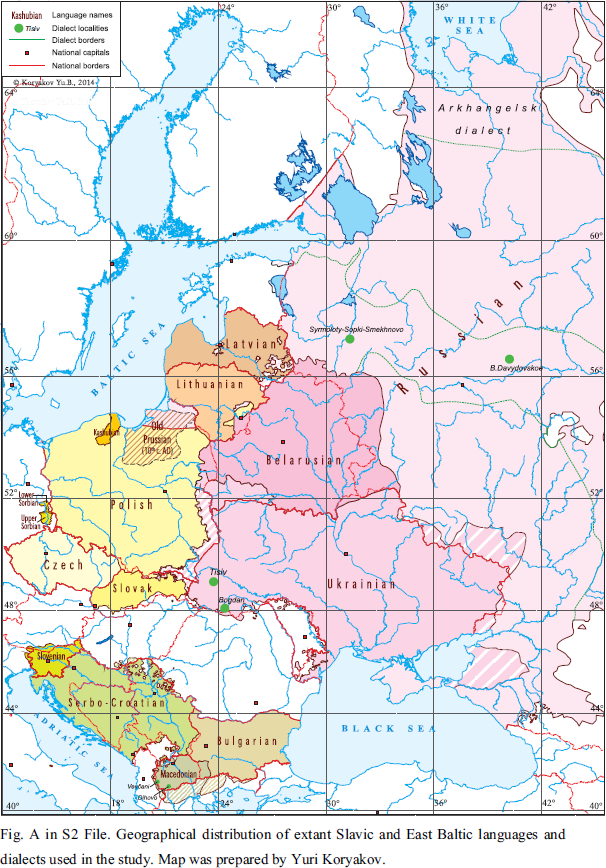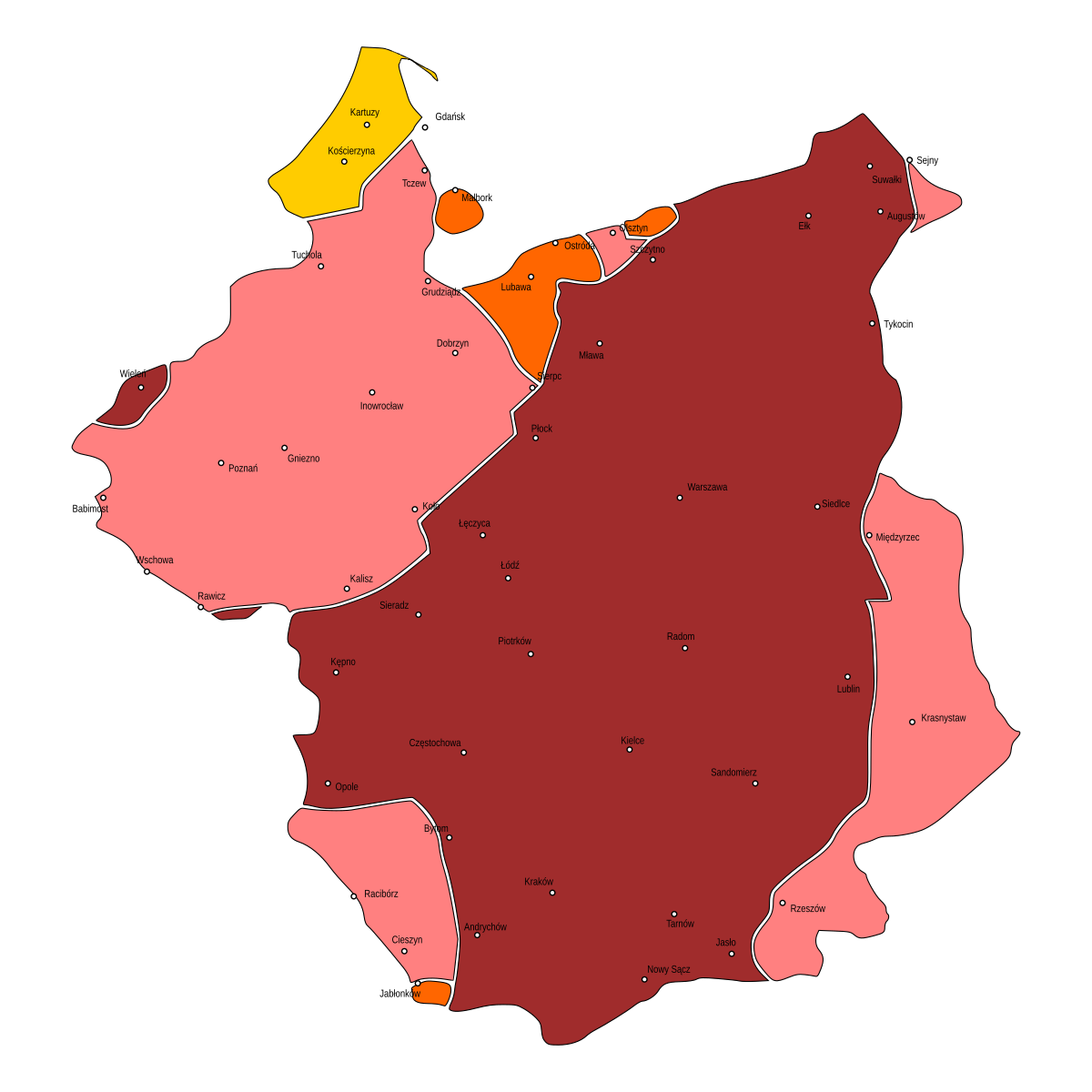|
Kurpie Dialect
The Kurpie dialect ( pl, gwara kurpiowska) belongs to the Masovian dialect group and is located in the part of Poland. It borders the Masurian dialects to the north and the Far Mazovian dialect to the south. The Kurpie dialect is generally well preserved, and a strong cultural connection to the dialect can be felt amongst speakers. Standard Polish is used by most people in the region, often alongside Kurpian, and code-switching between the two frequently happens. Phonology Typical of Masovian dialects, devoicing of word-final consonants before vowels and liquids is present here, including before clitics. Also typical of Masovian dialects is the presence of mazuration, however, due to influence from Standard Polish, this is disappearing. Vowels y phonemically merges with i (approaching it phonetically to ɪ), leaving the hardness of the previous consonant as the main phonemic determining factor: potraw·i (potrawy). Often the group er shifts to ir: dopsiro. Ablaut is often level ... [...More Info...] [...Related Items...] OR: [Wikipedia] [Google] [Baidu] |
Poland
Poland, officially the Republic of Poland, , is a country in Central Europe. Poland is divided into Voivodeships of Poland, sixteen voivodeships and is the fifth most populous member state of the European Union (EU), with over 38 million people, and the List of European countries by area, seventh largest EU country, covering a combined area of . It extends from the Baltic Sea in the north to the Sudetes and Carpathian Mountains in the south, bordering seven countries. The territory is characterised by a varied landscape, diverse ecosystems, and Temperate climate, temperate transitional climate. The capital and List of cities and towns in Poland, largest city is Warsaw; other major cities include Kraków, Wrocław, Łódź, Poznań, and Gdańsk. Prehistory and protohistory of Poland, Humans have been present on Polish soil since the Lower Paleolithic, with continuous settlement since the end of the Last Glacial Period over 12,000 years ago. Culturally diverse throughout ... [...More Info...] [...Related Items...] OR: [Wikipedia] [Google] [Baidu] |
Balto-Slavic Languages
The Balto-Slavic languages form a branch of the Indo-European family of languages, traditionally comprising the Baltic and Slavic languages. Baltic and Slavic languages share several linguistic traits not found in any other Indo-European branch, which points to a period of common development. Although the notion of a Balto-Slavic unity has been contested (partly due to political controversies), there is now a general consensus among specialists in Indo-European linguistics to classify Baltic and Slavic languages into a single branch, with only some details of the nature of their relationship remaining in dispute. A Proto-Balto-Slavic language is reconstructable by the comparative method, descending from Proto-Indo-European by means of well-defined sound laws, and from which modern Slavic and Baltic languages descended. One particularly innovative dialect separated from the Balto-Slavic dialect continuum and became ancestral to the Proto-Slavic language, from which all Slav ... [...More Info...] [...Related Items...] OR: [Wikipedia] [Google] [Baidu] |
Slavic Languages
The Slavic languages, also known as the Slavonic languages, are Indo-European languages spoken primarily by the Slavs, Slavic peoples and their descendants. They are thought to descend from a proto-language called Proto-Slavic language, Proto-Slavic, spoken during the Early Middle Ages, which in turn is thought to have descended from the earlier Proto-Balto-Slavic language, linking the Slavic languages to the Baltic languages in a Balto-Slavic languages, Balto-Slavic group within the Indo-European family. The Slavic languages are conventionally (that is, also on the basis of extralinguistic features) divided into three subgroups: East Slavic languages, East, South Slavic languages, South, and West Slavic languages, West, which together constitute more than 20 languages. Of these, 10 have at least one million speakers and official status as the national languages of the countries in which they are predominantly spoken: Russian language, Russian, Belarusian language, Belarusian ... [...More Info...] [...Related Items...] OR: [Wikipedia] [Google] [Baidu] |
West Slavic Languages
The West Slavic languages are a subdivision of the Slavic language group. They include Polish, Czech, Slovak, Kashubian, Upper Sorbian and Lower Sorbian. The languages have traditionally been spoken across a mostly continuous region encompassing the Czech Republic, Slovakia, Poland, the westernmost regions of Ukraine and Belarus, and a bit of eastern Lithuania. In addition, there are several language islands such as the Sorbian areas in Lusatia in Germany, and Slovak areas in Hungary and elsewhere. Classification West Slavic is usually divided into three subgroups— Czecho-Slovak, Lechitic and Sorbian—based on similarity and degree of mutual intelligibility. The groupings are as follows: Some linguists include Upper and Lower Sorbian in the Lechitic branch, but other linguists regard it as a separate branch. The reason for this is that 'the Sorbian dialects are extremely diverse, and there are virtually no linguistic features common to all Sorbian dialects which ... [...More Info...] [...Related Items...] OR: [Wikipedia] [Google] [Baidu] |
Lechitic Languages
The Lechitic (or Lekhitic) languages are a language subgroup consisting of Polish and several other languages and dialects that were once spoken in the area that is now Poland and eastern Germany. It is one of the branches of the larger West Slavic subgroup; the other branches of this subgroup are the Czech–Slovak languages and the Sorbian languages. Languages The Lechitic languages are: * Polish, used by approximately 38 million native speakers in Poland and several million elsewhere. Polish is considered to have several dialects, including Greater Polish, Lesser Polish and Masovian, among others; ** Silesian, used today by over 530,000 people (2011 census) in Polish Silesia and by some more in Czech Silesia. The different varieties of Silesian are often considered to be dialects of Polish and Czech, and are sometimes seen as forming a distinct language; * Pomeranian, spoken by Slavic Pomeranians, of which the only remaining variety is: ** Kashubian, used today by o ... [...More Info...] [...Related Items...] OR: [Wikipedia] [Google] [Baidu] |
Polish Language
Polish (Polish: ''język polski'', , ''polszczyzna'' or simply ''polski'', ) is a West Slavic language of the Lechitic group written in the Latin script. It is spoken primarily in Poland and serves as the native language of the Poles. In addition to being the official language of Poland, it is also used by the Polish diaspora. There are over 50 million Polish speakers around the world. It ranks as the sixth most-spoken among languages of the European Union. Polish is subdivided into regional dialects and maintains strict T–V distinction pronouns, honorifics, and various forms of formalities when addressing individuals. The traditional 32-letter Polish alphabet has nine additions (''ą'', ''ć'', ''ę'', ''ł'', ''ń'', ''ó'', ''ś'', ''ź'', ''ż'') to the letters of the basic 26-letter Latin alphabet, while removing three (x, q, v). Those three letters are at times included in an extended 35-letter alphabet, although they are not used in native words. The traditiona ... [...More Info...] [...Related Items...] OR: [Wikipedia] [Google] [Baidu] |
Masovian Dialect Group
The Masovian dialect group ( pl, dialekt mazowiecki), also Mazovian, is a dialect group of the Polish language spoken in Mazovia and historically related regions, in northeastern Poland. It is the most distinct of the Polish dialects and the most expansive. Mazovian dialects may exhibit such features as mazurzenie, sandhi (intervocalic voicing of obstruents on word boundaries), and asynchronous palatal pronunciation of labial consonants (so-called softening). Characteristics include: * Depalatalization of velars before and palatalization of velars before historical ; e.g. standard Polish ''rękę'', ''nogę'' ('arm', 'leg', in the accusative case) is rendered , respectively instead of , ; * sequences realized instead of ; * merger of the retroflex series sz, ż, cz, dż into the alveolar s, z, c, dz; * > before certain consonants; * the Old Polish dual number marker -''wa'' continues to be attached to verbs; * Standard Polish and merged with and respectively, in most si ... [...More Info...] [...Related Items...] OR: [Wikipedia] [Google] [Baidu] |
Masurian Dialects
The Masurian ethnolect (Masurian: ''mazurská gádkä''; ; ), according to some linguists, is a dialect group of the Polish language; others consider Masurian to be a separate language, spoken by the Masurian people in northeastern Poland. The dialect belongs to the Masovian dialect group and is located in the part of Poland as well as parts of Siberia. It borders the Lubawa dialect to the far southwest, the Ostróda dialect and Warmia dialect to the west, the new mixed dialects to the north, the Suwałki dialect to the east, marginally the Podlachia dialect to the far east, and the Kurpie dialect and Far Mazovian dialect to the south. History From the 14th century, some settlers from Masovia started to settle in southern Prussia, which had been devastated by the crusades of the Teutonic Knights against the native Old Prussians. According to other sources, people from Masovia did not move to southern Prussia until the time of the Protestant Reformation, Prussia having ... [...More Info...] [...Related Items...] OR: [Wikipedia] [Google] [Baidu] |
Far Mazovian Dialect
The Far Masovian dialect ( pl, gwary Mazowsza dalszego) belongs to the Masovian dialect group and is located in the part of Poland. It borders the Near Mazovian dialect to the south, the Podlachia dialect to the east, the Kurpie dialect and Masurian dialects to the north. and the Greater Polish Chełmno-Dobrzyń dialect to the west. Generally this dialect is fading, and many typical Masovian features are being replaced with Standard Polish features. Phonology Typical of Masovian dialects, devoicing of word-final consonants before vowels and liquids is present here, including before clitics. This does not affect prepositions. Also typical of Masovian dialects is the presence of masuration, but it is now a sporadic change, and forms not having undergone masuration are more common. Hypercorrections may also occur. Vowels The shift of initial ja-, ra- > je-, re- is present but limited to particular words: jek (jak), remię (ramię). Often this process is undone, as well. The shif ... [...More Info...] [...Related Items...] OR: [Wikipedia] [Google] [Baidu] |
Dialects Of The Polish Language
Polish dialects are regional vernacular varieties of the Polish language. Four major dialect groups are typically recognized, each primarily associated with a particular geographical region, and often further subdivided into subdialectal groups (termed ''gwara'' in Polish).Roland Sussex and Paul Cubberley (2006). ''The Slavic Languages''. Cambridge University Press. P. 530.Robert A. Rothstein (1994). "Polish". ''The Slavonic Languages'', edited by Bernard Comrie and Greville G. Corbett. Routledge. Pp. 754–756. They are: * Greater Polish, spoken in the west * Lesser Polish, spoken in the south and southeast * Masovian, spoken throughout the central and eastern parts of the country * Silesian spoken in the southwest (sometimes also considered a separate language, see comment below) The regional differences correspond mainly to old ethnic or tribal divisions from around a thousand years ago. As a result of 19th century measures taken by occupying powers, of expulsions plus o ... [...More Info...] [...Related Items...] OR: [Wikipedia] [Google] [Baidu] |
Languages Of Europe
Most languages of Europe belong to the Indo-European language family. Out of a total European population of 744 million as of 2018, some 94% are native speakers of an Indo-European language. Within Indo-European, the three largest phyla are Romance, Germanic, and Slavic, they have more than 200 million speakers each and together account for close to 90% of Europeans. Smaller phyla of Indo-European found in Europe include Hellenic ( Greek, 13 million), Baltic ( 7 million), Albanian ( 5 million), Celtic ( 4 million), Armenian ( 4 million) and Indo-Aryan (Romani, 1.5 million). Of the approximately 45 million Europeans speaking non-Indo-European languages, most speak languages within either the Uralic or Turkic families. Still smaller groups — such as Basque (language isolate), Semitic languages (Maltese language, Maltese, 0.5 million), and various languages of the Caucasus — account for less than 1% of the European population between them. Immigration has added siz ... [...More Info...] [...Related Items...] OR: [Wikipedia] [Google] [Baidu] |


